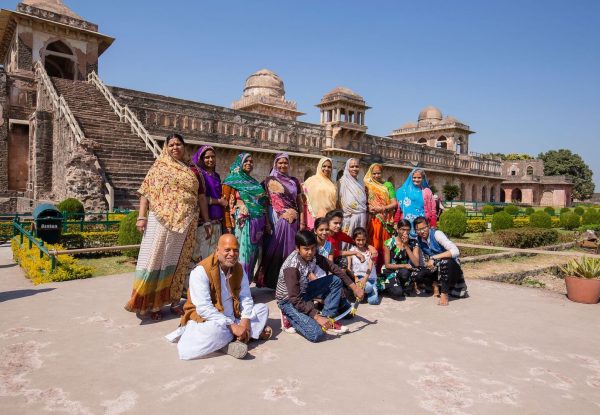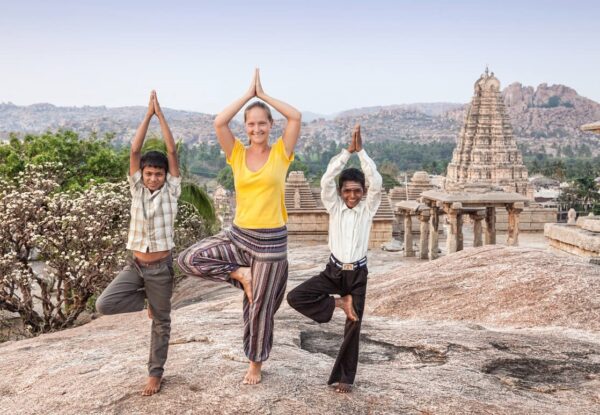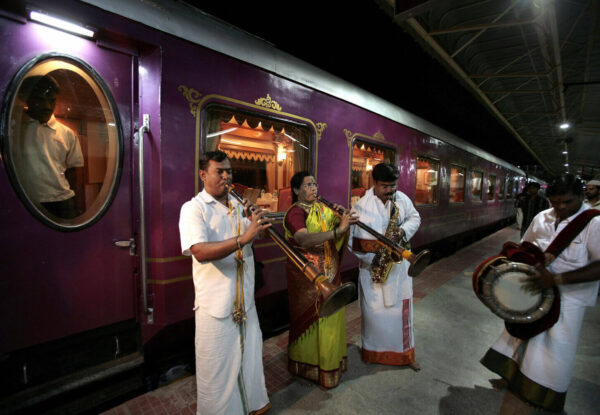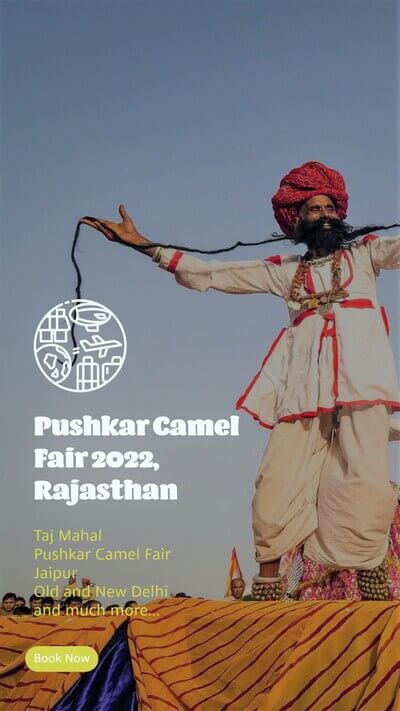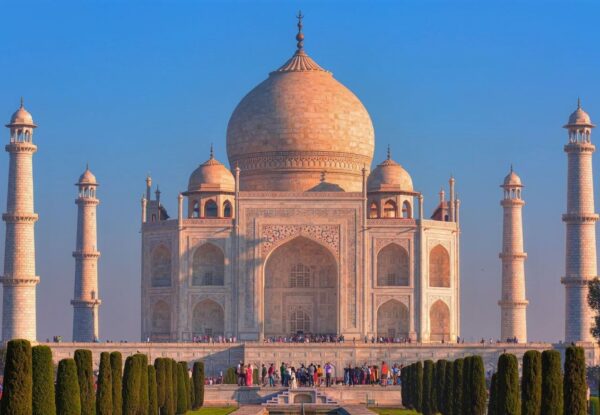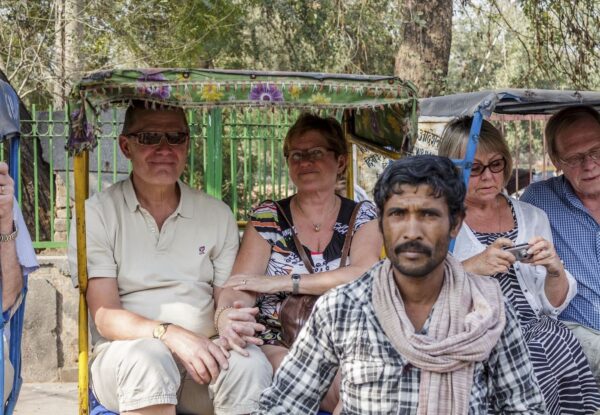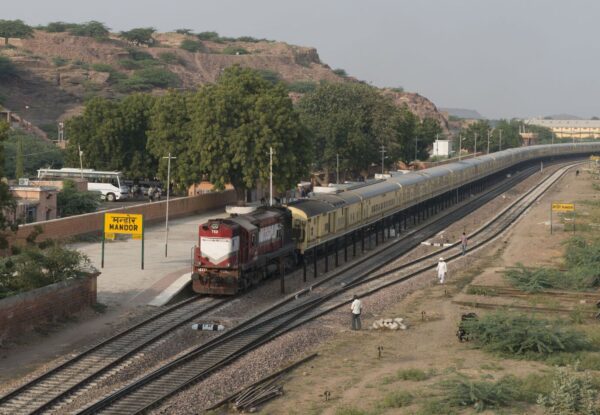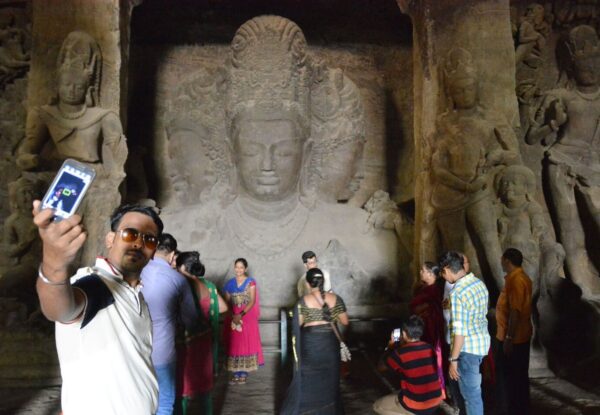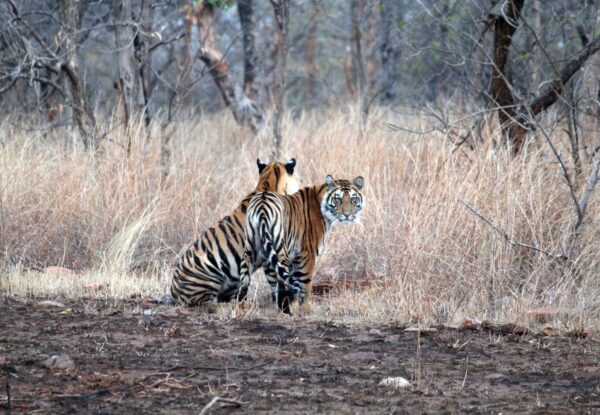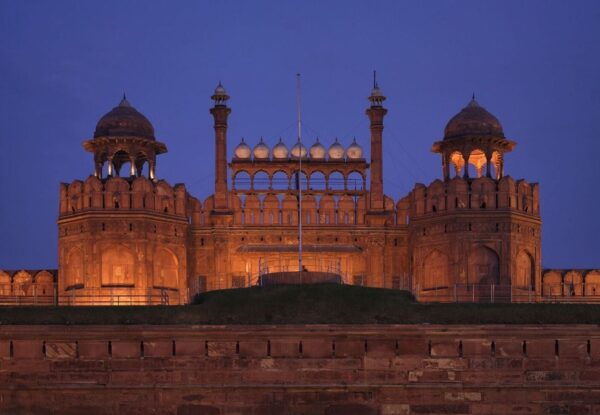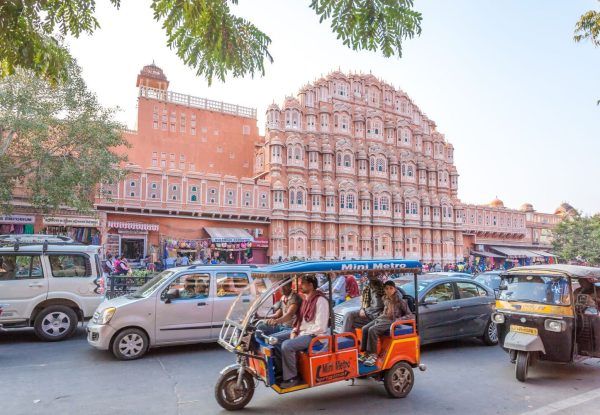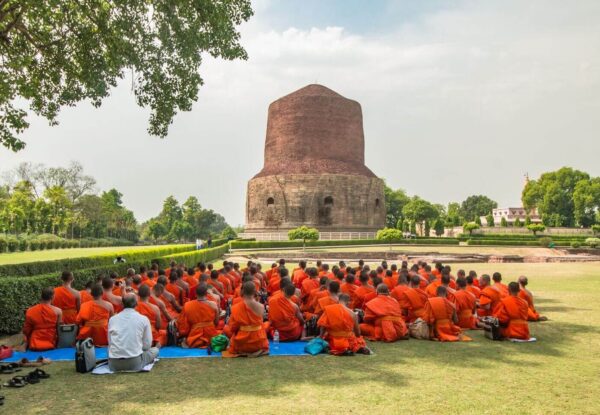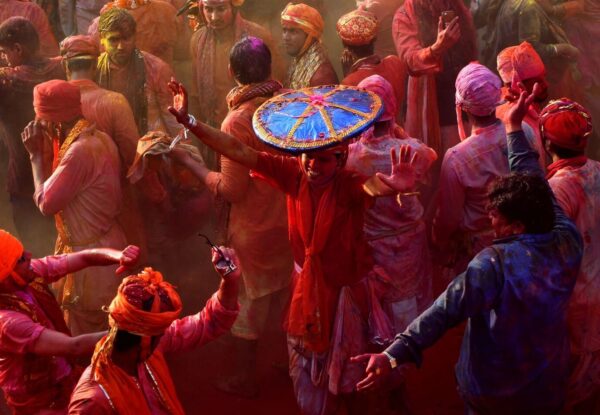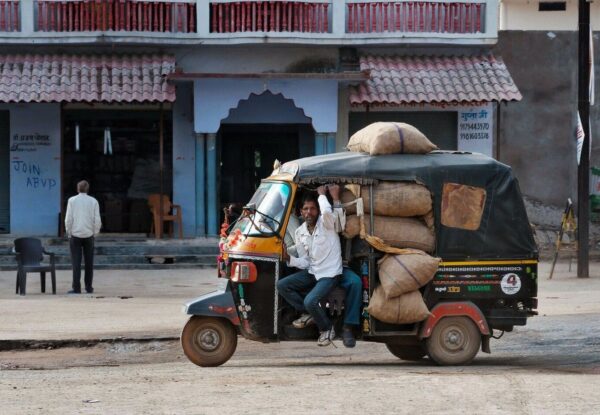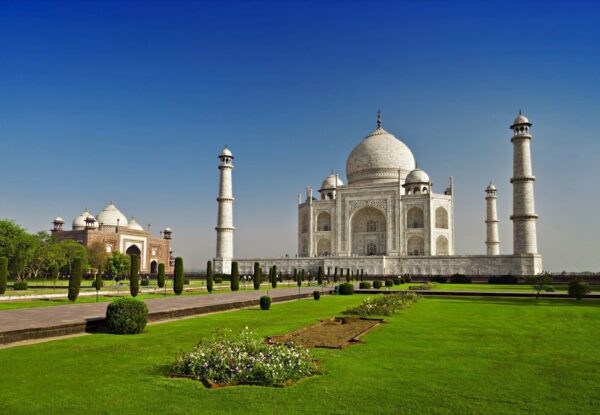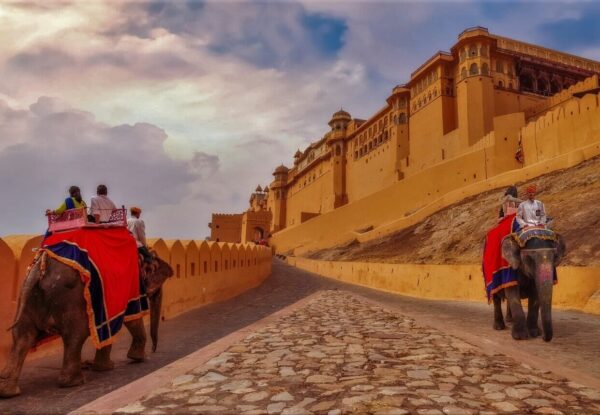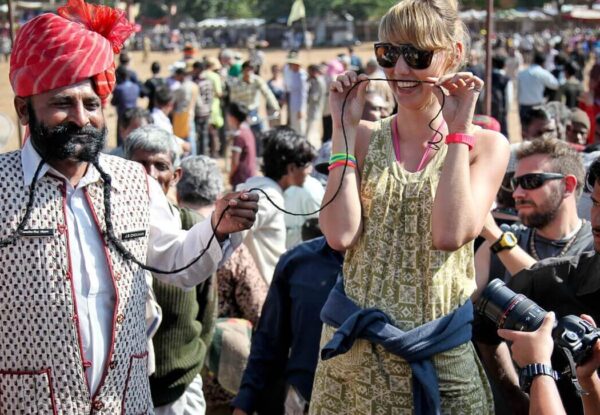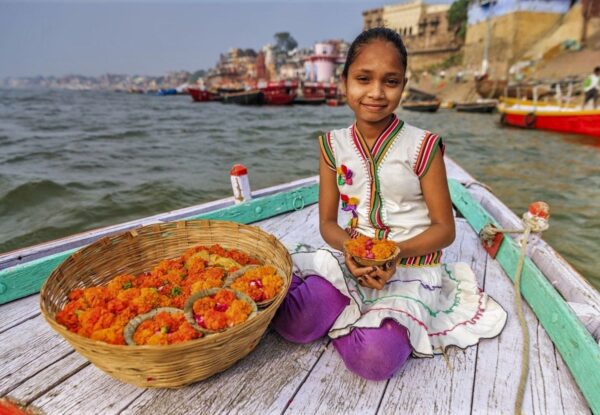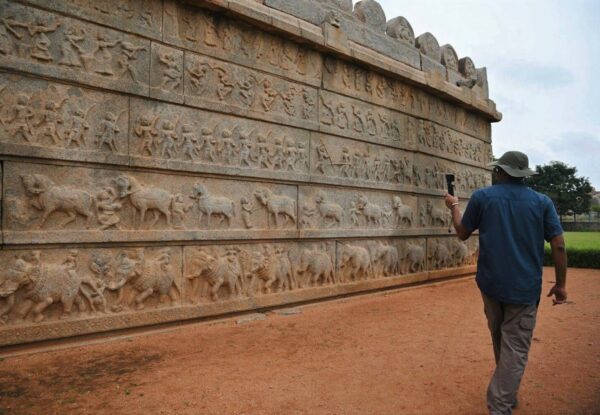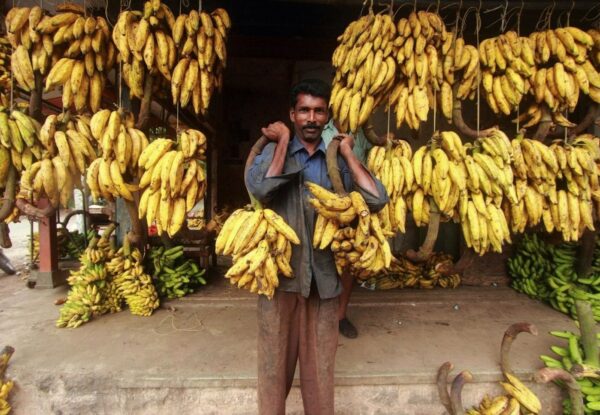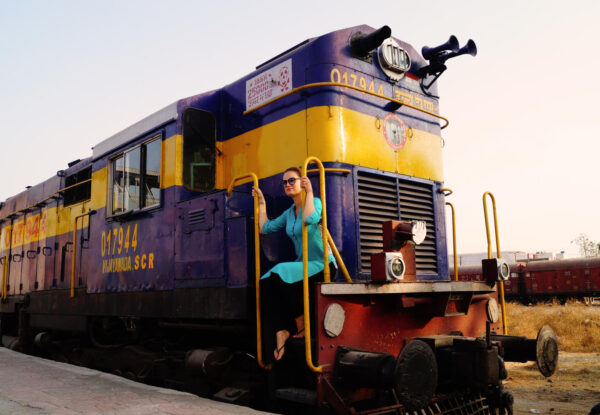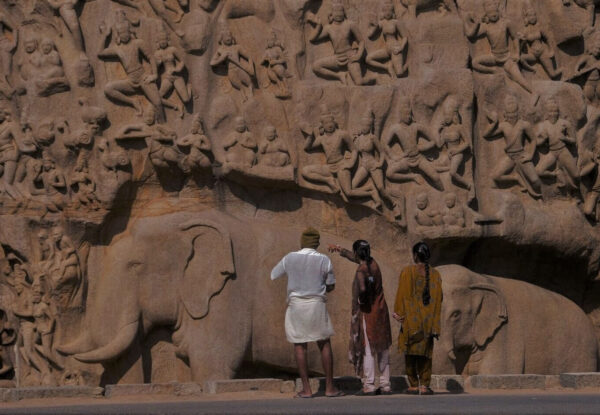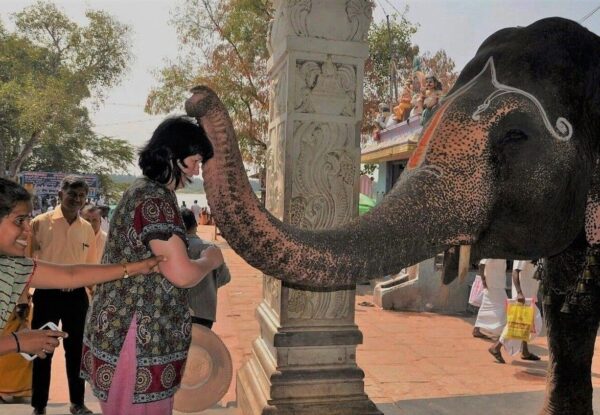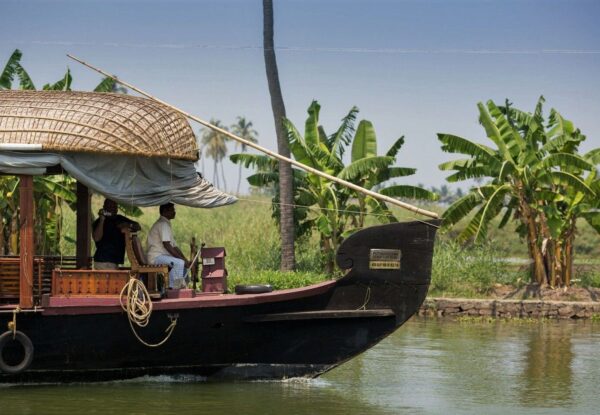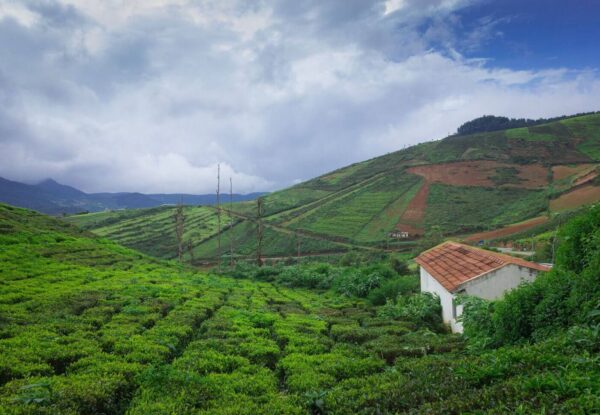Highlights of Best of North and South India Tour
Trip Details
- With this Vacation India Luxury Tour enjoy the sights and sounds of the cities of Northern India and Southern India, from Rajasthan, known as the Land of Kings, to the serene beaches of Mararikulam. You will experience the most luxurious travel including the Taj and Oberoi hotels.
- Your trip begins with a tour of Delhi, using the modern subway to explore beautiful gardens and the architecture of New Delhi. In the comfort of Indian tricycles, you continue on to fascinating Old Delhi to the old bazaars of Chandni Chowk and landmarks such as the Jama Masjid mosque, the Red Fort and the beautiful Raj Ghat park.
- Leaving Delhi, your Luxury North India Tour flies you to Rajasthan, and the city of Udaipur, the ‘Venice of the East’: one of the most romantic cities in India where you will visit the beautiful lakes of Fateh Sagar, Udai Sagar, Swaroop Sagar and Lake Pichola with the ornate Lake Palace hotel.
- From Udaipur you travel to Jodhpur, located on the eastern edge of the Great Indian Thar Desert. Jodhpur, the “Blue City” has an enchanting network of vividly blue painted houses surrounding the majestic Mehrangarh Fort and the 16th-century city wall. Inside the wall you will encounter the bustling, medieval streets, with the scent of incense and bazaars selling everything from spices to saris.
- From blue to pink, your next step is to Rajasthan’s state capital the enthralling historical city of Jaipur, the “Pink City”. As a major commercial center, the city streets buzz as buses dodge camels and leisurely cycle-rickshaws. You will discover Jaipur’s majestic past in the magnificent Amber Fort where you can experience an elephant ride, or visit the Jantar Mantar observatory, featuring the world’s largest stone sundial.
- Next you will travel to the city of Sawai Madhopur for a safari in the Ranthambhore National Park in search of the Bengal Tiger. With the Ranthambhore Fort, the 1334 sqkm Park is an enthralling experience of jungle, ancient temples, mosques, pavilions, and vine-covered tombs.
- From Ranthambhore you journey to Agra, on the banks of the Yamuna river, to experience the unique romance of the Taj Mahal, testament to Mughal architecture. You will also be delighted by a trip to the atmospheric and photogenic ruined city of Fatehpur Sikri.
- Leaving Agra, air conditioned train travel takes you on to the state of Uttar Pradesh and the city of Jhansi, gateway to the charming medieval village of Orchha, where you can relaxon the banks of the river Betwa, with its opulent abandoned palaces, graceful Chattris (cenotaphs) and beautiful surrounding countryside.
- Your journey will take you to the state of Madhya Pradesh, and Khajuraho to marvel at the Monuments that encapsulate the essence of Indian aesthetics, exhibiting fine examples of erotic temple art dedicated to Hinduism and Jainism.
- Your final destination in North India, Varanasi, known as the City of Life and located on the banks of the Ganges, is the center of spirituality in India where you will enjoy the Aarti ceremony and travel to Sarnath, following the footsteps of Buddha to the Dhamekh Stupa and Monastery where he preached his first sermon.
- Fly to Chennai to begin your enchanting South India tour. Begin your South Indian tour in Chennai, the capital of Tamil Nadu on the east coast of India
- See the sights of the rock cut pillars of Mahabalipuram and the centuries -old temples of Kanchipuram, the best kept ancient sites in South India
- Take in the distinctive Franco-Indian style of Puducherry (Pondicherry)
- Be awe struck by the splendor of Chola architecture at the Great Living Chola Temples of Gangaikonda Cholapuram, Darasuram’s Airavatesvara Temple, Thanjavur’s Brihadishwara Temple
- Discover the charm of the Chettinad region. Stay in a glorious mansion belonging to an original trader. View the earliest Burma teakwood pillars, Belgium glasses and granite flooring
- Admire Madurai’s breathtaking temples the greatest cultural, symbols of Southern India
- Look out for the wild elephants among the fantastic scenery at Periyar Tiger Reserve and learn how the world’s most popular spices are grown at the 500 -acre Spice Plantation in the beautiful Western Ghats
- Visit India’s first European colony, Fort Kochi on the Malabar Coast, settled by the Portuguese, Dutch and eventually the British
- Mingle with the local farmers in Munnar and explore their tea plantation and the factory where the world-famous tea is made!
- Enter “God’s own country” the Alleppey Backwaters. Relax, and enjoy the scenery in your private houseboat
- Be entertained by the exotic performances of the Kathakali dance in Kochi, with pulsating music and extravagant costumes and make-up
- Laze about at the grand beach resort of Mararikulam and enjoy some fun in the sun for 4 Nights.

India your way, your route, your style
• Price based on two persons in a double room
• Prices are in USD Excluding international flights
• Do you prefer to travel alone or would you like to come to India with a group of friends? We will be happy to tailor-made your tour program that meets all your wishes and needs
| Travel Period | PRICE PER PERSON | |
|---|---|---|
| Apr 1, 2024 – Mar 31, 2025 | from Price on Request (Deluxe) | INQUIRE NOW |
| Apr 1, 2024– Mar 31, 2025 | from Price on Request (Deluxe) | INQUIRE NOW |
Would you like to have the trip tailored to your wishes?
Our itineraries are only examples and suggestions and can be customized individually. For example, a trip can be shortened or extended with additional destinations or monuments, the hotels can be a mix of 4 and 5 star etc. Let us know your personal wishes so that we can adapt the trip to your wishes. Connect with our travel expert for a 1:1 consultation and receive your obligation free travel proposal. Together with the travel request we will send you the hotel list so that you can get a picture of the hotels selected on the internet. We promise ✔Competent and Friendly Guides ✔Expert Drivers ✔Best Hotels ✔24/7 Support. Read more on Why Vacation India?
Get in Touch: info@vacationindia.com / +91-99274-65808 (India Calling & Whatsapp) / USA/Canada: 1 (888) 414-6804
Services Included
- 28 days individual travel from New Delhi to Kochi
- 27 Nights in a double room or single room in selected hotels according to the booked category
- Daily breakfast
- A high quality air-conditioned car (Toyota Innova Crysta) with driver at your disposal during your entire stay
- Round trip, sightseeing and all excursions as mentioned in the tour program
- Services of a Local English speaking guide
- Two shared Jeep Safari in Ranthambore National Park
- First Class Train Ticket from Agra to Jhansi
- Private Boatride on Ganges at Sunrise and at Sunset with Guide
- Excursion to Sarnath in Varanasi
- Transfers airport – hotel – airport
- All entrances as described in the tour program
- Visit to the Taj Mahal in sunrise
- Boat ride on lake Pichola in Udaipur
- Golf cart transfer to Taj Mahal
- Elephant ride or Jeep to Amber Fort in Jaipur
- Visit of the Tiger Nahargarh Fort in Jaipur, where you have a unforgettable panorama of Jaipur can enjoy
- Guided Walk through the old pink city of Jaipur
- Rickshaw ride in Old Delhi
- Boat safari in the Periyar national park
- Visit to the Kalari Martial Arts Program in Thekkady
- Visit to the Kathakali dance program in Thekkady
- 2 liter bottles of mineral water per person per day
- 24 hours contact in India
- All taxes and fees, parking, fuel charges, tolls and interstate taxes etc.
Services not included
- International and Domestic Flights
- Any type of travel insurance
- Visa fees
- Main meals not mentioned
- Separate camera and video charges during the visits to
- Expense of personal nature like tipping, laundry, telephone/fax calls, alcoholic beverages, camera/video camera fee at monuments, medical expenses, etc.
There are no reviews yet. Be the first one to write one.
To receive the list of Hotels selected for this tour, please email us at info@vacationindia.com
Keywords: Best of North and South India Tour, best of north and south India combined tour.
Similar Tours You May Like
Top Destinations in Rajasthan Including Heritage Palace Hotels, the Taj Mahal and a Goa Beach Holiday
Old and New Delhi ➜ Jaipur ➜ Jodhpur ➜ Ranakpur ➜ Udaipur ➜ Sardargarh Heritage Palace Hotel ➜ Bundi ➜ Ranthambhore National Park ➜ Agra (Taj Mahal and Red Fort) ➜ New Delhi ➜ Fly to Goa ➜ New Delhi/ Mumbai
North India Sojourn with Taj and Oberoi Hotels
Old and New Delhi ➜ Udaipur ➜ Ranakpur ➜ Jodhpur ➜ Deogarh Palace Heritage Hotel ➜ Jaipur ➜ Ranthambore Tiger National Park ➜ Agra ➜ Fatehpur Sikri ➜ Orchha ➜ Khajuraho ➜ Varanasi ➜ New Delhi
Palace on Wheels – Luxury Train Tour through Rajasthan
New Delhi ➜ Jaipur ➜ Sawai Madhopur (Ranthambhore Tiger National Park) ➜ Chittorgarh ➜ Udaipur ➜ Jaisalmer ➜ Jodhpur ➜ Bharatpur (Keoladeo Bird National Park) ➜ Agra ➜ Delhi
India Getaway – Delhi to Mumbai
New Delhi ➜ Amritsar (Golden Temple) ➜ New Delhi➜ Agra ➜ Fatehpur Sikri ➜ Jaipur ➜ Sardargarh Fort Heritage Palace Hotel ➜ Udaipur ➜ Mumbai ➜ Elephanta Caves ➜ Mumbai
Royal Tiger Safari
New Delhi ➜ Sawai Madhopur ➜ Ranthambhore Tiger Reserve ➜ Gwalior ➜ Khajuraho ➜ Bandhavgarh National Park ➜ Kanha National Park ➜ Pench Tiger Reserve ➜ Tadoba National Park ➜ Mumbai
Cultural Heritage Tour of North India
Old and New Delhi ➜ Samode ➜ Jaipur ➜ Fatehpur Sikri ➜ Agra ➜ Orchha ➜ Khajuraho ➜ Varanasi (Ganges)
India Impressions
Mumbai ➜ Aurangabad (Ajanta & Ellora Caves) ➜ Indore ➜ Mandu ➜ Maheshwara & Omkareshwar ➜ Ujjain ➜ Bhopal ➜ Bhimbetka Caves and Bhojpur ➜ Jhalawar ➜ Rawatbhata ➜ Bundi ➜ Chittorgarh ➜ Mumbai or Delhi
The Grand Rajasthan Tour: Walk in the Footsteps of Maharajas
New Delhi ➜ Jaipur ➜ Agra ➜ Jaipur ➜ Nawalgarh (Shekhawati region including Mandawa & Fatehpur) ➜ Bikaner ➜ Deshnoke (Rat Temple) ➜ Jaisalmer (Sam Dunes) ➜ Osian ➜ Luni (Jodhpur and Bishnoi village) ➜ Mount Abu ➜ Kumbalgarh ➜ Ranakpur Jain Temple ➜ Udaipur ➜ Chittorgarh ➜ Bundi ➜ Pushkar ➜ Alwar ➜ New Delhi ➜ Goa ➜ New Delhi
Top Destinations in Rajasthan Including Heritage Palace Hotels, the Taj Mahal and a Goa Beach Holiday
Old and New Delhi ➜ Jaipur ➜ Jodhpur ➜ Ranakpur ➜ Udaipur ➜ Sardargarh Heritage Palace Hotel ➜ Bundi ➜ Ranthambhore National Park ➜ Agra (Taj Mahal and Red Fort) ➜ New Delhi ➜ Fly to Goa ➜ New Delhi/ Mumbai
Golden Triangle India + Varanasi (Ganges)
Old and New Delhi ➜ Agra ➜ Fatehpur Sikri ➜ Abhaneri Step-well ➜ Jaipur ➜ Varanasi (Ganges) & Sarnath – New Delhi
Holi Festival Tour 2024 – Holi in Vrindavan and Pushkar
Old Delhi and New Delhi ➜ Mathura ➜ Agra ➜ Jaipur ➜ Pushkar ➜ Deogarh Mahal Palace Hotel ➜ Rankpur ➜ Udaipur ➜ New Delhi
North India Sojourn with Taj and Oberoi Hotels
Old and New Delhi ➜ Udaipur ➜ Ranakpur ➜ Jodhpur ➜ Deogarh Palace Heritage Hotel ➜ Jaipur ➜ Ranthambore Tiger National Park ➜ Agra ➜ Fatehpur Sikri ➜ Orchha ➜ Khajuraho ➜ Varanasi ➜ New Delhi
Treasures of Central India (15 days)
New Delhi ➜ Indore ➜ Dhar ➜ Mandu ➜ Omkareshwar ➜ Maheshwara ➜ Ujjain ➜ Bhopal ➜ Sanchi and Udaygiri ➜ Bhimbetka Caves and Bhojpur ➜ Jabalpur ➜ Bandhavgarh Tiger National Park ➜ Khajuraho ➜ Orchha ➜ Jhansi ➜ Datia ➜ Sonagiri ➜ Gwalior ➜ Chambal Wildlife Sanctuary ➜ New Delhi + Optional tour of Taj Mahal
Golden Triangle + Tiger National Park
Old Delhi & New Delhi ➜ Agra ➜ Fatehpur Sikri ➜ Abhaneri ➜ Jaipur ➜ Ranthambore National Park ➜ Delhi
India Getaway – Delhi to Mumbai
New Delhi ➜ Amritsar (Golden Temple) ➜ New Delhi➜ Agra ➜ Fatehpur Sikri ➜ Jaipur ➜ Sardargarh Fort Heritage Palace Hotel ➜ Udaipur ➜ Mumbai ➜ Elephanta Caves ➜ Mumbai
India Impressions
Mumbai ➜ Aurangabad (Ajanta & Ellora Caves) ➜ Indore ➜ Mandu ➜ Maheshwara & Omkareshwar ➜ Ujjain ➜ Bhopal ➜ Bhimbetka Caves and Bhojpur ➜ Jhalawar ➜ Rawatbhata ➜ Bundi ➜ Chittorgarh ➜ Mumbai or Delhi
The Grand Rajasthan Tour: Walk in the Footsteps of Maharajas
New Delhi ➜ Jaipur ➜ Agra ➜ Jaipur ➜ Nawalgarh (Shekhawati region including Mandawa & Fatehpur) ➜ Bikaner ➜ Deshnoke (Rat Temple) ➜ Jaisalmer (Sam Dunes) ➜ Osian ➜ Luni (Jodhpur and Bishnoi village) ➜ Mount Abu ➜ Kumbalgarh ➜ Ranakpur Jain Temple ➜ Udaipur ➜ Chittorgarh ➜ Bundi ➜ Pushkar ➜ Alwar ➜ New Delhi ➜ Goa ➜ New Delhi
Top Destinations in Rajasthan Including Heritage Palace Hotels, the Taj Mahal and a Goa Beach Holiday
Old and New Delhi ➜ Jaipur ➜ Jodhpur ➜ Ranakpur ➜ Udaipur ➜ Sardargarh Heritage Palace Hotel ➜ Bundi ➜ Ranthambhore National Park ➜ Agra (Taj Mahal and Red Fort) ➜ New Delhi ➜ Fly to Goa ➜ New Delhi/ Mumbai
Best of Rajasthan
New Delhi ➜ Samode Village ➜ Jaipur ➜ Mandawa ➜ Khimsar ➜ Jodhpur ➜ Ranakpur ➜ Udaipur ➜ Bundi ➜ Ranthambhore National Park ➜ New Delhi
Rajasthan with Pushkar Camel Fair Tour 2023
New Delhi ➜ Mandawa ➜ Khimsar Desert Village (Khimsar Fort Palace Heritage Hotel) ➜ Jodhpur ➜ Udaipur ➜ Pushkar Camel Fair ➜ Jaipur ➜ Fatehpur Sikri ➜ Agra (Taj Mahal & Red Fort) ➜ New Delhi
Holi Festival Tour 2024 – Holi in Vrindavan and Pushkar
Old Delhi and New Delhi ➜ Mathura ➜ Agra ➜ Jaipur ➜ Pushkar ➜ Deogarh Mahal Palace Hotel ➜ Rankpur ➜ Udaipur ➜ New Delhi
North India Sojourn with Taj and Oberoi Hotels
Old and New Delhi ➜ Udaipur ➜ Ranakpur ➜ Jodhpur ➜ Deogarh Palace Heritage Hotel ➜ Jaipur ➜ Ranthambore Tiger National Park ➜ Agra ➜ Fatehpur Sikri ➜ Orchha ➜ Khajuraho ➜ Varanasi ➜ New Delhi
Palace on Wheels – Luxury Train Tour through Rajasthan
New Delhi ➜ Jaipur ➜ Sawai Madhopur (Ranthambhore Tiger National Park) ➜ Chittorgarh ➜ Udaipur ➜ Jaisalmer ➜ Jodhpur ➜ Bharatpur (Keoladeo Bird National Park) ➜ Agra ➜ Delhi
Rajasthan Tour with Taj Mahal, Khajuraho and Varanasi (16 days)
Old and New Delhi ➜ Varanasi (Ganges) ➜ Khajuraho ➜ Orchha ➜ Agra ➜ Fatehpur Sikri ➜ Jaipur ➜ Alsisar (Ancient Havelis / Shekhawati Region) ➜ Bikaner ➜ Jaisalmer ➜ Jodhpur ➜ Ranakpur ➜ Udaipur ➜ New Delhi
Pride of Karnataka – The Golden Chariot Train Journey through Karnataka
Bengaluru ➜ Bandipur National park ➜ Mysore (Srirangapatna) ➜ Halebidu ➜ Chikmagalur ➜ Hampi ➜ Badami, Aihole and Pattadakal ➜ Goa ➜ Bengaluru
Mumbai To Chennai
Mumbai ➜ Goa ➜ Hampi ➜ Belur ➜ Halebidu ➜ Mysore ➜ Wayanad ➜ Kochi ➜ Alleppey ➜ Varkala ➜ Kanyakumari ➜ Madurai ➜ Chettinad ➜ Pondicherry ➜ Tanjore ➜ Mahabalipuram ➜ Chennai
South India Tour – Best of Tamil Nadu and Kerala (15 days)
Chennai ➜ Kanchipuram ➜ Mahabalipuram (Mamallapuram) ➜ Pondicherry (Puducherry) ➜ Tanjore (Thanjavur) ➜ Trichy (Tiruchirapalli) ➜ Chettinad Region ➜ Madurai ➜ Munnar ➜ Thekkady (Periyar Tiger Reserve) ➜ Alleppey (Houseboat Kerala Backwaters) ➜ Kumarakom ➜ Mararikulam Beach ➜ Kochi ➜ Chennai
Golden Chariot Train Journey – Jewels of South
Bengaluru ➜ Mysore ➜ Hampi ➜ Mahabalipuram ➜ Thanjavur and Chettinad ➜ Kumarakom (Houseboat & Backwaters) ➜ Cochin ➜ Bengaluru
Grand South India Tour (31 Days)
Chennai (Madras) ➜ Kanchipuram ➜ Mahapalipuram (Mamallapuram) ➜ Pondicherry ➜ Darasuram & Gangaikondacholpuram ➜ Tanjore ➜ Trichy ➜ Chettinad ➜ Madurai ➜ Rameswaram ➜ Kanyakumari ➜ Kovalam ➜ Alleppey (Houseboat Tour) ➜ Kumarakom ➜ Periyar Tiger Reserve ➜ Munnar (Tea Plantations) ➜ Cochin (Kochi) ➜ Ooty ➜ Kabini and Nagarhole NationalpPark or Bandipur National Park ➜ Mysore (Srirangapatnam & Somnathpur) ➜ Hassan (Belur und Halebidu) ➜ Hampi ➜ Aihole & Pattadakal ➜ Badami ➜ Goa ➜ Chennai / Mumbai
Treasures of South India – Best of Tamil Nadu, Kerala and Karnataka (19 days)
Chennai ➜ Mahabalipuram ➜ Kanchipuram ➜ Puducherry ➜ Thanjavur ➜ Chettinad ➜ Madurai ➜ Thekkady (Periyar Tiger Reserve) ➜ Alleppey Backwaters ➜ Kochi (Cochin) ➜ Ooty ➜ Bandipur National Park ➜Mysore (Mysuru)➜ Shravanabelagola ➜ Belur and Halebidu ➜ Ancient City of Hampi ➜ Aihole and Pattadakal ➜ Badami ➜ Goa Beaches
Tropical Kerala with Madurai detour (15 days)
Kochi (Cochin) ➜ Houseboat through Backwaters ➜ Kumarakom ➜ Kovalam Beach ➜ Thekkady (Periyar Tiger Reserve) ➜ Madurai (Meenakshi Temple) ➜ Munnar (Tea Plantations) ➜ Mararikulam Beach
South India Wildlife and Trekking Tour
Madikeri (Coorg) ➜ Nishani Motte Trek ➜ Namdroling Monastery ➜ Kabini Wildlife Sanctuary ➜ Nagarhole National Park ➜ Ooty ➜ Pollachi ➜ Anamalai Tiger Reserve or Parambikulam Tiger Reserve ➜ Munnar ➜ Eravikulam National Park Madurai ➜ Chinnar Wildlife Sanctuary (Thoovanam Waterfalls) ➜ Madurai (Meenakshi Temple) ➜ Chennai


